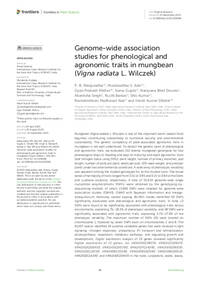Genome-wide association studies for phenological and agronomic traits in mungbean (Vigna radiata L. Wilczek)

Authors:
Mungbean (Vigna radiata L. Wilczek) is one of the important warm-season food legumes, contributing substantially to nutritional security and environmental sustainability. The genetic complexity of yield-associated agronomic traits in mungbean is not well understood. To dissect the genetic basis of phenological and agronomic traits, we evaluated 153 diverse mungbean genotypes for two phenological (days to heading and days to maturity) and eight agronomic traits (leaf nitrogen status using SPAD, plant height, number of primary branches, pod length, number of pods per plant, seeds per pod, 100-seed weight, and yield per plant) under two environmental conditions. A wide array of phenotypic variability was apparent among the studied genotypes for all the studied traits. The broad sense of heritability of traits ranged from 0.31 to 0.95 and 0.21 to 0.94 at the Delhi and Ludhiana locations, respectively. A total of 55,634 genome-wide single nucleotide polymorphisms (SNPs) were obtained by the genotyping-by-sequencing method, of which 15,926 SNPs were retained for genome-wide association studies (GWAS). GWAS with Bayesian information and linkage-disequilibrium iteratively nested keyway (BLINK) model identified 50 SNPs significantly associated with phenological and agronomic traits. In total, 12 SNPs were found to be significantly associated with phenological traits across environments, explaining 7%–18.5% of phenotypic variability, and 38 SNPs were significantly associated with agronomic traits, explaining 4.7%–27.6% of the phenotypic variability. The maximum number of SNPs (15) were located on chromosome 1, followed by seven SNPs each on chromosomes 2 and 8. The BLAST search identified 19 putative candidate genes that were involved in light signaling, nitrogen responses, phosphorus (P) transport and remobilization, photosynthesis, respiration, metabolic pathways, and regulating growth and development. Digital expression analysis of 19 genes revealed significantly higher expression of 12 genes, viz. VRADI01G08170, VRADI11G09170, VRADI02G00450, VRADI01G00700, VRADI07G14240, VRADI03G06030, VRADI02G14230, VRADI08G01540, VRADI09G02590, VRADI08G00110, VRADI02G14240, and VRADI02G00430 in the roots, cotyledons, seeds, leaves, shoot apical meristems, and flowers. The identified SNPs and putative candidate genes provide valuable genetic information for fostering genomic studies and marker-assisted breeding programs that improve yield and agronomic traits in mungbean.
